【知识精讲】动词不定式
动词不定式精讲

动词不定式归纳
“To do …”放在句首做主语
不定式做主语时,谓语动词常常用单数
eg.1:It is very important to drink enough water.
如果动词不定式太长,常用it作形式主语 “to do …”放在句末做真正主语,用“It” 放在句首引导
eg.2: To live up to a great reputation is very hard.
动词的v-ing 过去分词 v-ed
不定式
不定式由“to+动词原形”构成,其否定形式是 “not/never to do”,不定式可以带宾语或状语 构成不定式短语. 不定式的逻辑主语有时用“for+名词或代词宾 格”构成。
1.To know everything is to know nothing. 2.To say is one thing and to do is another story.
几对易混淆的词组: 1. stop to do sth stop doing sth
2. forget to do sth forget doing sth
3. remember to do sth remember doing sth
1. It is important ____one’s own limitations.
非谓语动词
1
什么是非谓 语动词啊?
“非谓语动词”,就 是不是谓语的动词呗!
那不是谓语 是什么呢?
。。。。 。。
Hale Waihona Puke 英语一句话只能有一个主谓结构 如果出现更多动词: 加连词(and / but / so…) 放入从句 非谓语动词
主语、谓语、宾语、定语、状语、补语
初中英语知识点总结:动词不定式
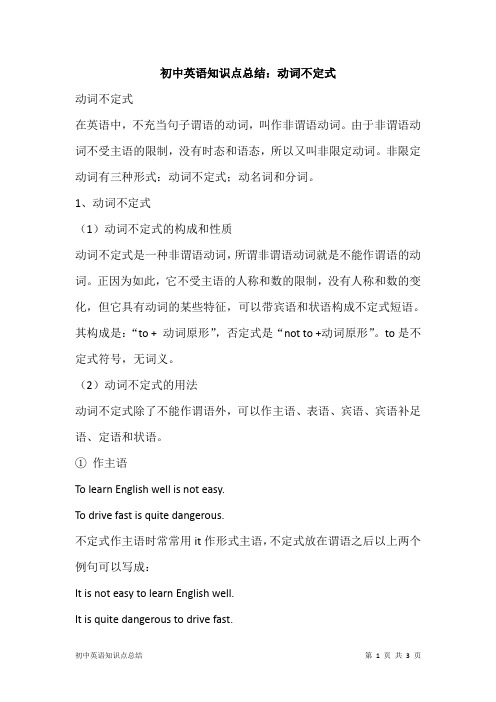
初中英语知识点总结:动词不定式动词不定式在英语中,不充当句子谓语的动词,叫作非谓语动词。
由于非谓语动词不受主语的限制,没有时态和语态,所以又叫非限定动词。
非限定动词有三种形式:动词不定式;动名词和分词。
1、动词不定式(1)动词不定式的构成和性质动词不定式是一种非谓语动词,所谓非谓语动词就是不能作谓语的动词。
正因为如此,它不受主语的人称和数的限制,没有人称和数的变化,但它具有动词的某些特征,可以带宾语和状语构成不定式短语。
其构成是:“to + 动词原形”,否定式是“not to +动词原形”。
to是不定式符号,无词义。
(2)动词不定式的用法动词不定式除了不能作谓语外,可以作主语、表语、宾语、宾语补足语、定语和状语。
①作主语To learn English well is not easy.To drive fast is quite dangerous.不定式作主语时常常用it作形式主语,不定式放在谓语之后以上两个例句可以写成:It is not easy to learn English well.It is quite dangerous to drive fast.这种用法可以归纳成这样一个句型:It is (not) + 形容词+ (for sb.) to do sth.It is very expensive for me to buy a car.It is very difficult for a child to do that job.有些形容词之后跟of + 名词(代词宾语)+不定式。
如:It is very kind of you to say so. It is very good of you to come.②作表语。
如:My job is to teach English. The first thing is to ring him up.③作宾语。
如:She wanted to ask you a question. He forgot to turn off the light. We decided to hold a class meeting.常见的可以用不定式作宾语的动词有:like, love, begin, start, try, ask, prefer, hate, find等,有些形容词可接不定式,这种不定式也可作宾语。
初三英语动词不定式知识精讲
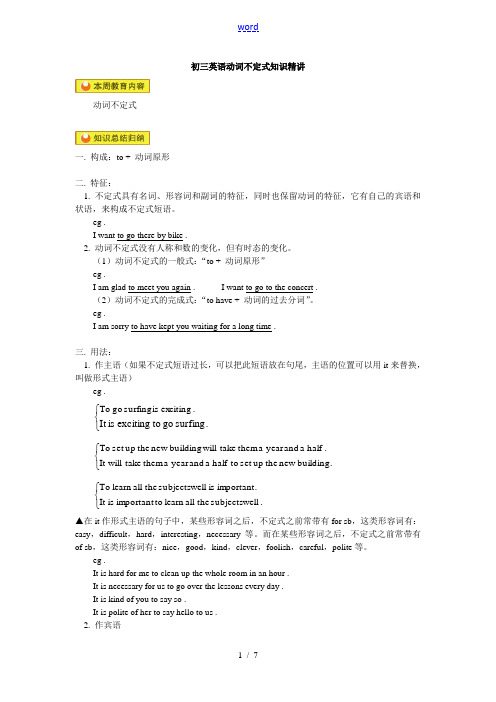
初三英语动词不定式知识精讲动词不定式一. 构成:to + 动词原形二. 特征: 1. 不定式具有名词、形容词和副词的特征,同时也保留动词的特征,它有自己的宾语和状语,来构成不定式短语。
eg .I want to go there by bike .2. 动词不定式没有人称和数的变化,但有时态的变化。
(1)动词不定式的一般式:“to + 动词原形”eg .I am glad to meet you again . I want to go to the concert .(2)动词不定式的完成式:“to have + 动词的过去分词”。
eg .I am sorry to have kept you waiting for a long time .三. 用法:1. 作主语(如果不定式短语过长,可以把此短语放在句尾,主语的位置可以用it 来替换,叫做形式主语)eg .⎩⎨⎧.surfing go to exciting is It .exciting is surfing go To ⎩⎨⎧.building new the up set to half a and year a them take will It .half a and year a them take will building new the up set To ⎩⎨⎧.well subjects the all learn to important is It .important is well subjects the all learn To ▲在it 作形式主语的句子中,某些形容词之后,不定式之前常带有for sb ,这类形容词有:easy ,difficult ,hard ,interesting ,necessary 等。
而在某些形容词之后,不定式之前常带有of sb ,这类形容词有:nice ,good ,kind ,clever ,foolish ,careful ,polite 等。
非谓语动词用法精讲动词不定式与被动语态的用法
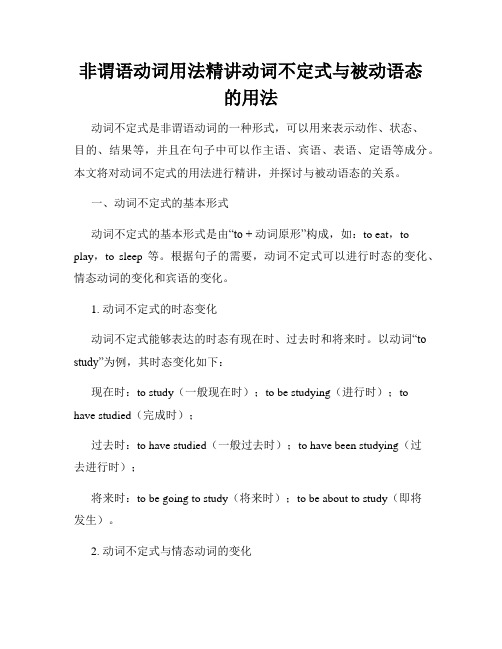
非谓语动词用法精讲动词不定式与被动语态的用法动词不定式是非谓语动词的一种形式,可以用来表示动作、状态、目的、结果等,并且在句子中可以作主语、宾语、表语、定语等成分。
本文将对动词不定式的用法进行精讲,并探讨与被动语态的关系。
一、动词不定式的基本形式动词不定式的基本形式是由“to + 动词原形”构成,如:to eat,to play,to sleep等。
根据句子的需要,动词不定式可以进行时态的变化、情态动词的变化和宾语的变化。
1. 动词不定式的时态变化动词不定式能够表达的时态有现在时、过去时和将来时。
以动词“to study”为例,其时态变化如下:现在时:to study(一般现在时);to be studying(进行时);to have studied(完成时);过去时:to have studied(一般过去时);to have been studying(过去进行时);将来时:to be going to study(将来时);to be about to study(即将发生)。
2. 动词不定式与情态动词的变化情态动词与动词不定式联用时,情态动词的形式保持不变,而动词不定式则仍保持原来的基本形式。
如:I can swim.(我会游泳。
)She must be careful.(她必须小心。
)He should apologize.(他应该道歉。
)3. 动词不定式作宾语动词不定式常常作为动词的宾语,说明动作或状态的对象。
常见的动词有want, hope, decide, plan, try, like等。
如:She wants to learn Chinese.(她想学中文。
)I hope to visit Beijing next year.(我希望明年去北京。
)4. 动词不定式作表语动词不定式还可以作表语,说明主语的身份、职业、爱好等。
如:Her dream is to be a teacher.(她的梦想是成为一名教师。
动词不定式知识点

动词不定式知识点一、动词不定式的基本概念。
1. 定义。
- 动词不定式是由“to+动词原形”构成(有时可以省略to),它在句中不能单独作谓语,但具有名词、形容词和副词的特征,可以在句中作主语、宾语、表语、定语、状语和补语等成分。
例如:- To see is to believe.(作主语和表语,“眼见为实”)2. 形式。
- 一般式:to do,表示动作与谓语动词同时发生或发生在谓语动词之后。
例如:I want to go to the park tomorrow.(go这个动作发生在want之后)- 进行式:to be doing,表示动作正在进行,与谓语动词同时发生。
例如:He seems to be reading a book.(read这个动作正在进行,与seem同时)- 完成式:to have done,表示动作发生在谓语动词之前。
例如:I'm sorry to have kept you waiting.(keep you waiting这个动作发生在am sorry之前)- 完成进行式:to have been doing,表示动作从过去一直持续到现在,并且可能还会继续下去。
例如:She is said to have been working on this project for years.二、动词不定式在句中的用法。
1. 作主语。
- 直接作主语时,常用it作形式主语,而将真正的主语(动词不定式)后置。
例如:- It is difficult to learn English well.(真正的主语是to learn English well,it是形式主语)- 但是,当动词不定式作主语的句子中有表语形容词时,也可以直接将动词不定式置于句首。
例如:- To be honest is very important.2. 作宾语。
- 动词不定式可以作某些及物动词的宾语,常见的这类动词有want, hope, wish, decide, manage, expect等。
初三英语语法知识汇总 动词不定式

动词不定式一、动词不定式的基本形式肯定式:to+动词原形否定式:not to+动词原形(to是不定式符号、标志,无意义,可以不翻译。
)二、动词不定式的特征动词不定式是一种非谓语动词形式,它没有人称和数的变化,但有时态和语态的变化,在句子中不能作谓语,但可以作除谓语之外的其它任何句子成分(主语、表语、宾语、宾语补足语、定语和状语);动词不定式具有名词、形容词和副词的特征,同时还保持动词的某些特点,即可以有自己的宾语和状语。
动词不定式和它的宾语和状语构成不定式短语。
三、动词不定式的用法1. 不定式作宾语能跟不定式作宾语的动词(及物动词)很多,构成vt.(及物动词)+to do sth. 结构。
常见的有:want, like, wish, hate, hope, prefer, try, ask, start, begin, decide, learn, choose, agree, expect , remember, forget等。
eg. He wanted to borrow my CD players. 他想借我的CD播放机。
His brother is learning to drive. 他弟弟正在学驾驶。
I hope to speak English well. 我希望讲好英语。
动词不定式作宾语其后又有补足语时,常用it作形式宾语,而把不定式后置。
eg. I find it difficult to learn physics. 我发现学习物理很难。
2. 不定式作宾语补足语动词不定式位于及物动词的宾语后,补充说明宾语,作补足语。
构成vt.+sb.+(not)to do sth. 结构。
常用带to的动词不定式作宾语补足语的动词结构有want sb.to do, ask sb.to do, tell sb.to do, order sb.to do, get sb.to do, wish sb.to do, allow sb.to do, invite sb.to do, teach sb.to do, encourage sb.to do, beg sb.to do等。
初中英语知识点归纳动词的不定式

初中英语知识点归纳动词的不定式动词的不定式是英语中的重要语法现象之一,学好不定式的用法可以帮助我们更好地理解和运用英语。
本文将对初中英语中动词的不定式进行归纳总结,以便同学们能够更加系统地掌握这一知识点。
一、动词的不定式形式英语中的动词不定式形式为“to + 动词原形”,其中“to”为不定式符号。
不定式的形式通常不受主语的人称和数的限制,一般用作动词、名词、形容词的宾语或补语。
二、不定式作动词的宾语动词不定式可以作为其他动词的宾语,常见的动词有:want, hope, plan, like, love, hate, enjoy等。
例如:1. I want to be a doctor when I grow up.(我长大后想当一名医生。
)2. They like to play basketball in their free time.(他们闲暇时喜欢打篮球。
)三、不定式作名词的补语不定式可以作为某些动词后的名词的补语,常见的动词有:be, become, seem, feel, appear等。
例如:1. Her dream is to become a famous singer.(她的梦想是成为一名著名的歌手。
)2. It seems to be a nice day for a picnic.(今天似乎是个适合野餐的好天气。
)四、不定式作形容词的补语不定式可以作为某些形容词后的补语,常见的形容词有:happy, sad, glad, ready, willing等。
例如:1. He is happy to help others.(他乐意帮助别人。
)2. I am ready to take on the challenge.(我准备好迎接挑战。
)五、不定式作目的状语不定式可以作为目的状语,表示动作的目的或者用途。
常见的动词有:go, come, try, learn, study等。
八年级动词不定式的知识点

八年级动词不定式的知识点动词不定式是英语中的一种非限定性从句,可以作为名词、形容词和副词等成分。
在英语中,它有其特殊的结构和用法,同时也是英语语法中的重要知识点之一。
一、基本结构动词不定式一般由“to+动词原形”构成,例如:to go,to eat等等。
二、作为名词1. 动词不定式作主语动词不定式作为主语时,位于句首,后面跟随谓语动词,例如:To learn English well is very important.学好英语十分重要。
2. 动词不定式作宾语动词不定式作直接宾语时,常用于某些动词(如want, expect, agree, hope, promise等)的宾语从句中,例如:I want to see you tomorrow.明天我想见你。
三、作为形容词1. 动词不定式作定语动词不定式作定语时作为形容词,并修饰名词或代词,例如:I have a book to read.我有一本要读的书。
2. 动词不定式作表语动词不定式作表语时作为形容词,并与be动词连用,例如:His dream is to be a doctor.他的梦想是成为一名医生。
四、作为副词1. 目的状语动词不定式作目的状语表示主语动作的目的或者原因,位于谓语动词之后,例如:I went to the supermarket to buy some fruits.我去超市买水果了。
2. 结果状语动词不定式作结果状语表示主语动作的结果或者后果,位于谓语动词之后,例如:He talked too much to be heard.他说得太多,没人听得懂。
以上就是八年级动词不定式的知识点,掌握好这些知识点,能够更好地理解英语语法,提升自己的英语语言水平。
动词不定式知识点
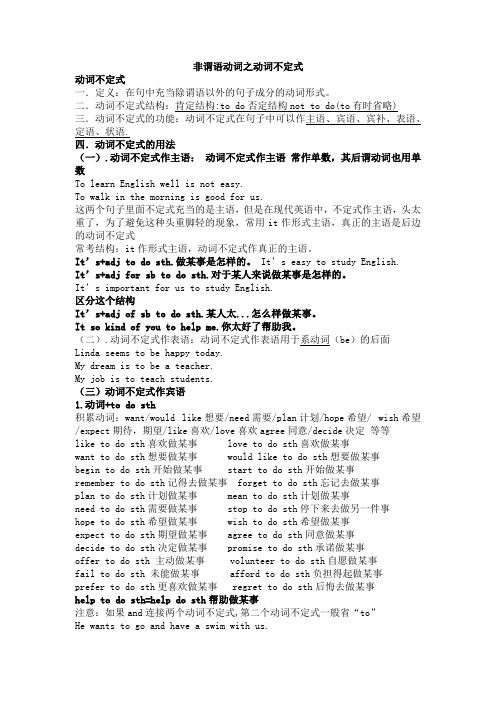
非谓语动词之动词不定式动词不定式一.定义:在句中充当除谓语以外的句子成分的动词形式。
二.动词不定式结构:肯定结构:to do否定结构not to do(to有时省略) 三.动词不定式的功能:动词不定式在句子中可以作主语、宾语、宾补、表语、定语、状语.四.动词不定式的用法(一).动词不定式作主语:动词不定式作主语常作单数,其后谓动词也用单数To learn English well is not easy.To walk in the morning is good for us.这两个句子里面不定式充当的是主语,但是在现代英语中,不定式作主语,头太重了,为了避免这种头重脚轻的现象,常用it作形式主语,真正的主语是后边的动词不定式常考结构:it作形式主语,动词不定式作真正的主语。
It’s+adj to do sth.做某事是怎样的。
It’s easy to study English.It’s+adj for sb to do sth.对于某人来说做某事是怎样的。
It’s important for us to study English.区分这个结构It’s+adj of sb to do sth.某人太...怎么样做某事。
It so kind of you to help me.你太好了帮助我。
(二).动词不定式作表语:动词不定式作表语用于系动词(be)的后面Linda seems to be happy today.My dream is to be a teacher.My job is to teach students.(三)动词不定式作宾语1.动词+to do sth积累动词:want/would like想要/need需要/plan计划/hope希望/ wish希望/expect期待,期望/like喜欢/love喜欢agree同意/decide决定等等like to do sth喜欢做某事 love to do sth喜欢做某事want to do sth想要做某事 would like to do sth想要做某事begin to do sth开始做某事 start to do sth开始做某事remember to do sth记得去做某事 forget to do sth忘记去做某事plan to do sth计划做某事 mean to do sth计划做某事need to do sth需要做某事 stop to do sth停下来去做另一件事hope to do sth希望做某事 wish to do sth希望做某事expect to do sth期望做某事 agree to do sth同意做某事decide to do sth决定做某事 promise to do sth承诺做某事offer to do sth 主动做某事 volunteer to do sth自愿做某事fail to do sth 未能做某事 afford to do sth负担得起做某事prefer to do sth更喜欢做某事 regret to do sth后悔去做某事help to do sth=help do sth帮助做某事注意:如果and连接两个动词不定式,第二个动词不定式一般省“to”He wants to go and have a swim with us.他想和我们一起去游泳.2.若作宾语的动词不定式很长,可用it作形式宾语. 动词+it+adj(for sb)to do sth make/find/think +it+adj(for sb)to do sthI find it interesting to learn English with you.我觉得和你一起学英语很有趣.He found it hard to catch up with others.他觉得赶上别人很困难.(四)动词不定式作宾语补足语放在宾语后,有三种情况1.动词+sb to do sth.积累动词:want/would like想要/allow允许/ask询问/wish希望/expect期待,期望/tell告诉order命令/advise建议等等want sb to do sth 想要某人做某事would like sb to do sth想要某人做某事allow sb to do sth允许某人做某事ask sb to do sth要求某人做某事request sb to sth要求某人做某事require sb to do sth要求某人做某事wish sb to do sth希望某人做某事expect sb to do sth期望某人做某事tell sb to do sth告诉某人做某事teach sb to do sth教某人做某事order sb to do sth命令某人做某事advise sb to do sth建议某人做某事invite sb to do sth邀请某人做某事encourage sb to do sth鼓励某人做某事2.跟不带to的的不定式作宾补:动词+sb+ do sth使役动词和感官动词let sb do sth 让某人做某事 have sb do sth 让某人做某事make sb do sth 让某人做某事 see sb do sth 看见某人做某事watch sb do sth看见某人做某事 hear sb do sth听见某人做某事notice sb do sth 注意某人做某事 feel sb do sth感觉某人做某事3.可跟to或不跟to的不定式作宾补help sb do sth帮助某人做某事help sb to do sth帮助某人做某事(五).动词不定式作定语:动词不定式作定语常用来修饰名词或不定代词,放于所修饰的词后,为后置定语I have some work to do.我有一些要做的工作。
动词不定式精讲

动词不定式精讲1. 作主语作主语的不定式如果很短,通常位于句首,如:To see is to believe.若不定式(短语)较长时,常用it作形式主语,而把真正的主语(即动词不定式)放在后面,以避免头重脚轻。
常见句型为:“It”s +名词(for + sb)+ to do sth“和”It“s +形容词(for / of + sb)+ to do sth”。
注意:在这个句型结构中,若形容词表示与人有关的“赞美”或“批评”时用of,如kind,nice,good,clever,bad等;否则用for.如:It“s easy for you to answer the question.It“s very kind of you to help me.2. 作表语动词不定式可以作be,seem,appear等系动词的表语。
如:Her job is to take care of these children.3. 作状语动词不定式放在come,go,stop等动词后作目的状语;放在sorry,glad,surprised,pleased,angry等形容词后作原因状语;动词不定式作状语表示结果时常与副词too或enough连用。
注意:too…to与so…that…和(not)…enough to…可以相互转换:如:She is so weak that she can“t move the box.=She is too weak to move the box.=She is not strong enough to move the box.4. 疑问词+不定式疑问词+不定式=名词短语,可作主语、宾语或表语。
注意:名词短语可以由名词从句转换而来;疑问代词what,which,whom可以作宾语,疑问副词how,when,where,whether不能作宾语。
如:I didn“t know what I should do. = I didn”t know wheat to do.I didn“t know how I should do it. = I didn”t know how to do it.5. 几种不带to的动词不定式句式had better…, Why not…? Will / Would you please…?等句型后接不带to的不定式。
动词不定式知识点详解(初中英语专项复习)4
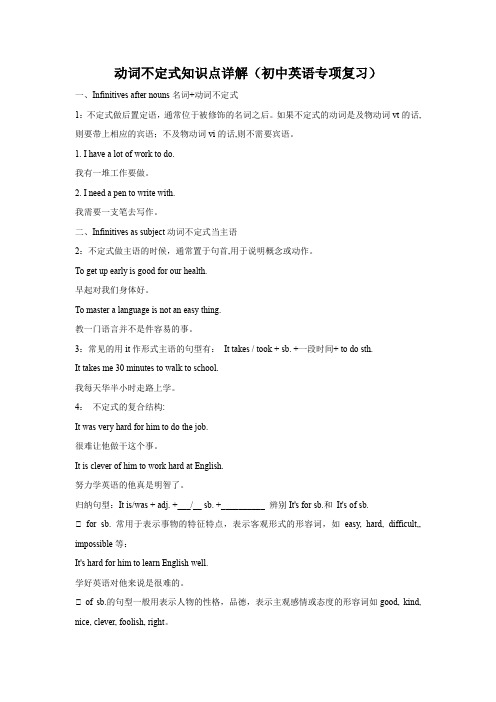
动词不定式知识点详解(初中英语专项复习)一、Infinitives after nouns名词+动词不定式1:不定式做后置定语,通常位于被修饰的名词之后。
如果不定式的动词是及物动词vt的话,则要带上相应的宾语;不及物动词vi的话,则不需要宾语。
1. I have a lot of work to do.我有一堆工作要做。
2. I need a pen to write with.我需要一支笔去写作。
二、Infinitives as subject动词不定式当主语2:不定式做主语的时候,通常置于句首,用于说明概念或动作。
To get up early is good for our health.早起对我们身体好。
To master a language is not an easy thing.教一门语言并不是件容易的事。
3:常见的用it作形式主语的句型有:It takes / took + sb. +一段时间+ to do sth.It takes me 30 minutes to walk to school.我每天华半小时走路上学。
4:不定式的复合结构:It was very hard for him to do the job.很难让他做干这个事。
It is clever of him to work hard at English.努力学英语的他真是明智了。
归纳句型:It is/was + adj. +___/__ sb. +__________ 辨别It's for sb.和It's of sb.① for sb. 常用于表示事物的特征特点,表示客观形式的形容词,如easy, hard, difficult,, impossible等:It's hard for him to learn English well.学好英语对他来说是很难的。
① of sb.的句型一般用表示人物的性格,品德,表示主观感情或态度的形容词如good, kind, nice, clever, foolish, right。
2022届高三英语一轮语法知识梳理之动词不定式
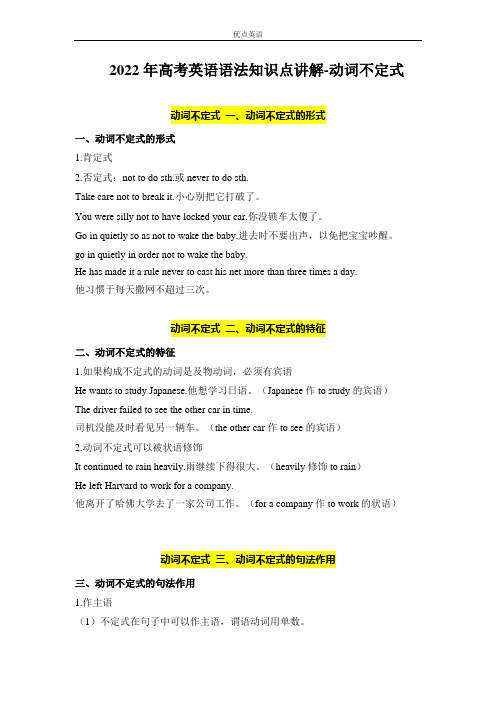
2022年高考英语语法知识点讲解-动词不定式动词不定式一、动词不定式的形式一、动词不定式的形式1.肯定式2.否定式:not to do sth.或never to do sth.Take care not to break it.小心别把它打破了。
You were silly not to have locked your car.你没锁车太傻了。
Go in quietly so as not to wake the baby.进去时不要出声,以免把宝宝吵醒。
go in quietly in order not to wake the baby.He has made it a rule never to cast his net more than three times a day.他习惯于每天撒网不超过三次。
动词不定式二、动词不定式的特征二、动词不定式的特征1.如果构成不定式的动词是及物动词,必须有宾语He wants to study Japanese.他想学习日语。
(Japanese作to study的宾语)The driver failed to see the other car in time.司机没能及时看见另一辆车。
(the other car作to see的宾语)2.动词不定式可以被状语修饰It continued to rain heavily.雨继续下得很大。
(heavily修饰to rain)He left Harvard to work for a company.他离开了哈佛大学去了一家公司工作。
(for a company作to work的状语)动词不定式三、动词不定式的句法作用三、动词不定式的句法作用1.作主语(1)不定式在句子中可以作主语,谓语动词用单数。
To study hard is necessary.努力学习是有必要的。
To get up early is a good habit.早起是个好习惯。
动词不定式精讲
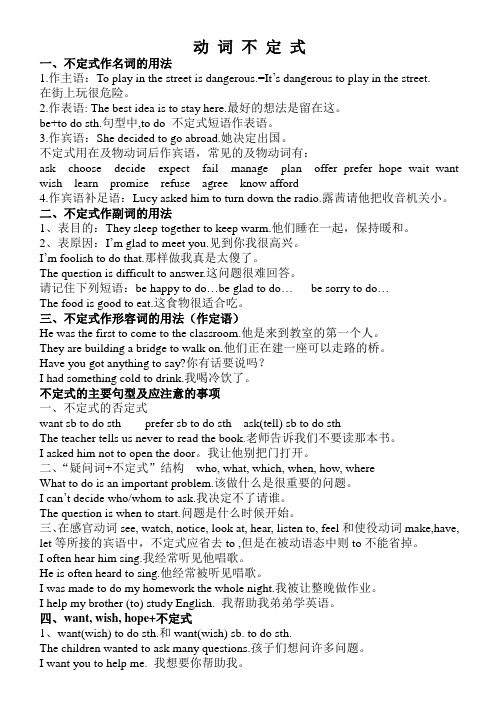
动词不定式一、不定式作名词的用法1.作主语:To play in the street is dangerous.=It’s dangerous to play in the street.在街上玩很危险。
2.作表语: The best idea is to stay here.最好的想法是留在这。
be+to do sth.句型中,to do 不定式短语作表语。
3.作宾语:She decided to go abroad.她决定出国。
不定式用在及物动词后作宾语,常见的及物动词有:ask choose decide expect fail manage plan offer prefer hope wait want wish learn promise refuse agree know afford4.作宾语补足语:Lucy asked him to turn down the radio.露茜请他把收音机关小。
二、不定式作副词的用法1、表目的:They sleep together to keep warm.他们睡在一起,保持暖和。
2、表原因:I’m glad to meet you.见到你我很高兴。
I’m foolish to do that.那样做我真是太傻了。
The question is difficult to answer.这问题很难回答。
请记住下列短语:be happy to do…be glad to do…be sorry to do…The food is good to eat.这食物很适合吃。
三、不定式作形容词的用法(作定语)He was the first to come to the classroom.他是来到教室的第一个人。
They are building a bridge to walk on.他们正在建一座可以走路的桥。
Have you got anything to say?你有话要说吗?I had something cold to drink.我喝冷饮了。
高一英语非谓语动词—动词不定式及动名词知识精讲

高一英语非谓语动词—动词不定式与动名词【本讲主要内容】非谓语动词——动词不定式与动名词【知识总结归纳】非谓语动词包括动词不定式,动名词和分词.〔1〕非谓语动词不可以单独作谓语,在形式上不受人称和数的限制.〔2〕非谓语动词如果是与物动词, 应该带宾语.〔3〕非谓语动词可以有状语来修饰.〔4〕非谓语动词仍有时态和语态的变化.I.动词不定式: to + 动词原形动词不定式具有名词,形容词和副词的特征,在句子中可以作主语,表语,宾语,定语和状语。
1. 作主语:To talk with him is a great pleasure.动词不定式作主语时, 往往放在谓语动词的后面,用作形式主语.It is a great pleasure to talk with him.有很多形容词都可以放在这个句型中:difficult, easy, hard, impossible, dangerous, safe, expensive, cheap impossibleDo you think it is safe to drink this water?Your writing is awful. It is impossible to read it.I like being with Jill. It’s very interesting to talk to her.It is not difficult to learn a foreign language if you spend time and effort on it.在形容词kind, clever, silly, stupid, careless, unfair , considerate 等前应该用介词of.It’s silly of Mary to give up her job when she needs the money.I think it was very helpful of them to tell me the truth.2. 作表语:Her wish is to become a teacher when she grows up.Our plan is to finish the plan in two weeks.3. 作宾语:Do you like to watch football matches?We decided to make changes in our plan.常见的后面跟不定式作宾语的动词有:offer, decide, agree, plan, hope, learn, forget, fail, attempt, promise, arrange, afford, manage等.How old were you when you learn to drive?We decided not to go out because of the bad weather.I promised not to be late.有些形容词后面也可以接动词不定式ready, eager, anxious, able, sure, glad, sorry, afraid, free, pleased, willingThe boys and girls are eager to learn to swim.I’m sorry to trouble you.He is willing to help the people in need.有些动词后可以用疑问词+ 不定式的结构ask, decide, know, remember, forget , explain ,learn, wonderWe asked how to get to the airport?Have you decided where to go for your holidays?Do you understand what to do?4. 作宾补:可以带宾补的动词有:ask, order, persuade, advise, like, want, tell, know, helpwarn, invite, persuade, get, expect, would like, would loveThe doctor advised him to have a good rest.I didn’t move the piano by myself. I got somebody to help me.I was warned not to touch the switch.My father allowed me to use his car.在某些与物动词的复合宾语中, 动词不定式要省掉to, 常见的省to的动词有:make, let, have, see, watch, hear, feel , help等I heard him speak in the next room.Liz suddenly felt something touch her on the shoulder.I saw him fall off the wall.Did anybody see the accident happen?The ending of the story made me feel sad.5. 作定语:动词不定式作定语时须放在被修饰的名词或代词之后.He is always the first one to get up.I have a few words to say on this question.Attention, please! I have something important to say.6. 作状语:不定式作状语通常表示目的或结果---- Why did you go out?---- To post a letter.A friend of mine phoned to invite me to a party.A few years later he came home to find that his hometown had greatly changed.I went to see him only to find him out.II. 动名词由动词原形+ 词尾ing 构成.动名词有名词的特征, 在句中可以作主语, 宾语,表语等.1. 作主语:Getting up early is a good habit.Seeing is believing.Reading aloud is very important in learning English.It’s no use trying to persuade me.There’s nothing you can do about the situation, so it’s no good worrying ab out it.2. 作表语:Her job is looking after the babies.His hobby is collecting stamps.3. 作宾语:常跟动名词作宾语的动词:stop, delay, consider, admit, miss, finish, postpone, imagine, avoid, risk practiseSuddenly everybody stopped talking. There was silentce.I’ll do the shopping when I’ve finished cleaning the flat.He tried to avoid answering my question.Have you ever considered going to live in another country.一些短语后面也用动名词做宾语:give up, put off, carry on, go on, keep onHe has given up smokingWe must do something. We can’t go on living like that.Don’t keep interrupting me while I’m speaking.介词后接动名词作宾语:before, after, be interested in, be good at, how about, instead of, in spite of, without, be used to, look forward to, have difficulty in, succe ed in, insist on, think of, feel like, stop… from, Are you interested in working for us?I’m not very good at learning languages.Carol went to work in spite of feeling ill.I bought a new bicycle instead of going away on holiday.What did you do after leaving school?I ran ten kilometers without stopping.Do you feel like going out tonight?The police stopped everyone from leaving the building.【高考点拨】【题型展示】〔〕 1. The patient was warned _____ oily food after the operation.A. to eat notB. eating notC. not to eatD. not eating此题应选C, warn sb. not to do sth. 意思是警告某人不要做某事.〔〕 2. The purpose of new technologies is to make life easier , __________ it more difficult .A. not makeB. not to makeC. not makingD. do not make此题应选B, 动词不定式在这里是作表语的.〔〕 3. Robert is said ______ abroad, but I don’t know what country he studied in.A. to have studiedB. to studyC. to be studyingD. to have been studying此题应选A, sb. be said to be, 意思是据说, 在这里用不定式的完成时, 指的是发生在过去的事.〔〕 4. I’ve worked with children before , so I know what ______ in my new job.A. expectedB. to expectC. to be expectingD. expects此题应选B, know 后面接动词不定式,不定式前面可以带一个疑问词.〔〕 5. The managers discussed the plan that they would like to see ______ the next year.A. carry outB. carrying outC. carried outD. to carry out此题应选C, plan 为定语从句的先行词, 后面为它的定语从句. 在从句中, 短语see sth. done 意思是“看见…被….〞〔〕 6. I usually go there by train.--- Why ______ going there by boat for a change?A.don’t tryB. not tryC. not to tryD. not trying此题应选B, why not do sth. 为一个词组, 表示一种建议语气.〔〕7. We don’t know who stole the book. What’s you r opinion?--- Jack is considered _______ it.A. having doneB. doingC. to have doneD. to do此题应选B, consider 后面应该用动名词作宾语.〔〕8. The place is really beautiful . We all think it worth ______ .A. being visitedB. to be visitedC. a visitD. to visit此题应选C, worth 后面可以跟动名词作它的宾语,A、B、D答案都不是,因此我们选择名词作宾语.〔〕9. He advised _____ at the school gate the next day.A. our meetingB. to meetC. us meetingD. met此题应选A, advise 后接动名词作宾语, 动名词前面可以有一个逻辑主语,用形容词性的物主代词.〔〕10. The computer is _______ to be one of the greatest inventions of the 20th century.A. regardedB. consideredC. expectedD. suggested此题应选B, consider 在这里是认为的意思. c onsider sb. to be ….【实战模拟】〔〕 1. The experienced driver has got ______ in all kinds of weather.A. used to driveB. used to drivingC. use to driveD. use to driving〔〕2. I’m too tired. I prefer _____ rather than go to the cinema.A. to stay homeB. to staying homeC. stay homeD. staying home〔〕 3. Her father considered _____ to a foreign friend.A. writingB. writeC. to writeD. wrote〔〕 4. You’d better _____ tell a lie. I think it ______ tell the teacher all that had happened yesterday.A. not. would betterB. not, is better toC. not to, would better toD. not to, better〔〕 5. The young couple came to the ball without ______ .A. being invitedB. invitingC. been invitedD. invite〔〕 6. He was surprised to find the back window of his house ______ . He was evenmore surprised to find his computer ______ .A. broken, goneB. had broken, goingC. being broken, disappearedD. had been broken, missed〔〕7. Please speak a little louder to make yourself _____ .A. to hearB. hearC. heardD. hearing〔〕8. The dish isn’t warm enough now. You’d better get it _____ .A. to heatB. to be heatedC. heatedD. heating〔〕9. --- What’s in your bag?--- Books _________to the teacher tomorrow.A. sentB. to be sentC. being sentD. sending〔〕10. I can hardly imagine Peter _____ across the Atlantic Ocean in five hours.A. sailB. to sailC. sailingD. to have sailed试题答案1. B2. A3. A4. B5. A6. A.7. C8.C9. B 10. C。
初中英语语法精讲动词不定式用法

动词不定式用法英语动词的非谓语形式为三种:动词不定式、动名词和分词。
动词不定式是一种非谓语动词形式,其结构为“to+动词原形”,其否定形式是not to+do。
其中to不是介词,而是动词不定式的符号,称为小品词,动词不定式没有人称和数的变化。
动词不定式和其后面的名词等构成不定式短语,在句子中可以用作主语、表语、宾语、补足语、定语、状语等下面以动词不定式在句中的作用来予以详细说明。
1.作主语可以直接作主语。
如:To see is to believe.但在英语中,常用it作形式主语,真正的主语即动词不定式放在后面。
如:It's useful for us to help other people.It's our duty to keep our environment clean and tidy.点击规律:动词不定式在句中作主语时,常放在It is +adj.(+for sb)+to do sth.或It is +n.(名词)+to do sth.句型中,it仅作形式主语,真正的主语是不定式。
2.作宾语a.want,decide ,agree等动词后面跟并且只能跟不定式。
如:We agreed to start early.She wants to be a doctor.b.love,like ,begin,start,hate 等词后面可以接不定式。
点击规律:上述动词后面除接不定式外,还可以接动名词,意思无很大区别。
提示板:like doing指经常性动作,而like to do指一次性的动作。
如:I like swimming,but I don't like to swim now.我喜欢游泳,但我现在不想游。
c.stop,forget,remember,go on ,try等词或短语后面可以接不定式。
点击规律:上述动词后面接不定式和接动名词意思大不相同。
提示板:1)stop to do sth.:停止一件事,去做另一件事。
高中英语非谓语动词精讲精练—动词不定式
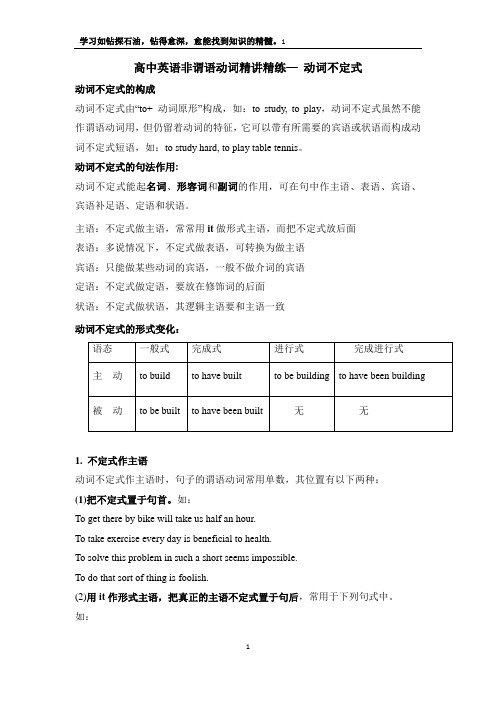
高中英语非谓语动词精讲精练—动词不定式动词不定式的构成动词不定式由“to+ 动词原形”构成,如:to study, to play,动词不定式虽然不能作谓语动词用,但仍留着动词的特征,它可以带有所需要的宾语或状语而构成动词不定式短语,如:to study hard, to play table tennis。
动词不定式的句法作用:动词不定式能起名词、形容词和副词的作用,可在句中作主语、表语、宾语、宾语补足语、定语和状语。
主语:不定式做主语,常常用it做形式主语,而把不定式放后面表语:多说情况下,不定式做表语,可转换为做主语宾语:只能做某些动词的宾语,一般不做介词的宾语定语:不定式做定语,要放在修饰词的后面状语:不定式做状语,其逻辑主语要和主语一致动词不定式的形式变化:1. 不定式作主语动词不定式作主语时,句子的谓语动词常用单数,其位置有以下两种:(1)把不定式置于句首。
如:To get there by bike will take us half an hour.To take exercise every day is beneficial to health.To solve this problem in such a short seems impossible.To do that sort of thing is foolish.(2)用it作形式主语,把真正的主语不定式置于句后,常用于下列句式中。
如:①It+be+名词+to doIt’s our duty to take good care of the old.②It takes sb+ some time +to doHow long did it take you to finish the work?③It+be+形容词+for sb+to doIt is difficult for us to finish writing the composition in a quarter of an hour.④It+be+形容词+of sb+to doIt is stupid of you to write down everything the teachersays.⑤It seems (appears) +形容词+to do seem 常用句式为“It seems that …..”和“sb seems to do sth …..”表示“似乎、好像”的意思。
高中英语知识点归纳动词的不定式
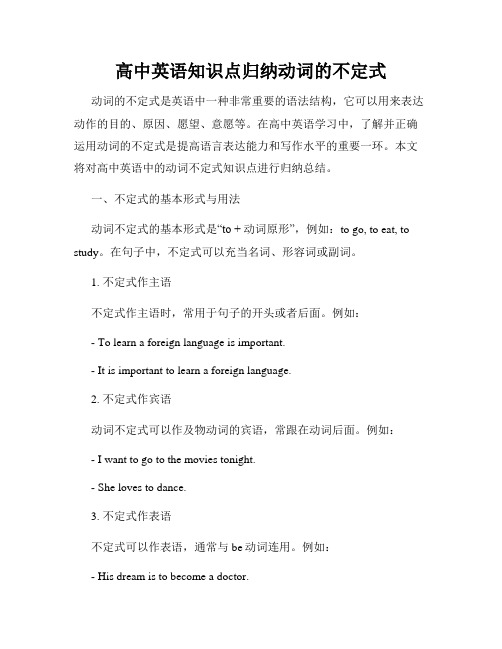
高中英语知识点归纳动词的不定式动词的不定式是英语中一种非常重要的语法结构,它可以用来表达动作的目的、原因、愿望、意愿等。
在高中英语学习中,了解并正确运用动词的不定式是提高语言表达能力和写作水平的重要一环。
本文将对高中英语中的动词不定式知识点进行归纳总结。
一、不定式的基本形式与用法动词不定式的基本形式是“to + 动词原形”,例如:to go, to eat, to study。
在句子中,不定式可以充当名词、形容词或副词。
1. 不定式作主语不定式作主语时,常用于句子的开头或者后面。
例如:- To learn a foreign language is important.- It is important to learn a foreign language.2. 不定式作宾语动词不定式可以作及物动词的宾语,常跟在动词后面。
例如:- I want to go to the movies tonight.- She loves to dance.3. 不定式作表语不定式可以作表语,通常与be动词连用。
例如:- His dream is to become a doctor.4. 不定式作定语动词不定式可以修饰名词,充当名词的定语。
例如:- She has a book to read.5. 不定式作状语动词不定式可以作状语,修饰动词、形容词或副词,表达动作的目的、原因、结果等。
例如:- He went to the store to buy some groceries.(目的)- She is too young to watch that movie.(结果)二、动词不定式的时态与语态动词不定式有时态和语态的变化,主要包括一般式、进行式、完成式和被动式。
1. 一般式一般式表示动作或状态的普遍性、一般性。
例如:- I like to play basketball.2. 进行式进行式表示动作正在进行。
第十二章动词不定式(思维导图+知识梳理+好题精炼)2022-2023初中英语中考语法归纳

第十二章动词不定式思维导图知识梳理一、不定式概述动词不定式的基本形式是:“t o+动词原形”,有时可以不带to.不带to的不定式与动词原形同形,但它不是原形,而是一种语法形式.除基本助动词do和情态动词外,英语动词都有不定式形式.动词不定式没有人称和数的变化,在句子中不能作谓语,但可以担任除谓语外的任何成分-主语、表语、宾语、定语、状语和宾语补足语.动词不定式和它的宾语或状语构成不定式短语.不定式有时态、语态变化(以do为例):主动语态被动语态一般式to do to be done进行式to be doing -完成式to have done to have been done 完成进行式to have been doing -(一)作主语用作主语的动词不定式通常表示一种具体的、特定的行为,其谓语动词用第三人称单数形式.To obey the laws is everyone's duty.服从法律是每个人的职责.How to use the computer is a question.怎么使用计算机是一个问题.How to get there is not decided yet.怎样去那里还没决定下来.点拨(1)在很多情况下,常用it作形式主语,而把真实主语不定式放在谓语之后.It was difficult to sell my car.我的车很难卖掉.It's not known where to stay for the night.在哪里过夜还不知道.(2)如果要表示不定式的动作是谁做的,一般在不定式前加一个for短语.It will be a regret for us not to help him.我们没有帮助他是个遗憾.(3)在某些形容词(如kind, good, nice, wise, unwise, clever, silly, wrong, right, foolish, stupid, careless, considerate, rude, naughty, impolite等)作表语时,不定式前常可加一个以of引起的短语,来说明不定式指的是谁的情况.It would be rude of us to refuse their invitation.(我们)拒绝他们的邀请,会显得无礼.(二)作表语作表语,一般紧跟在系动词,如:be, seem, get等后面,用以说明主语.The question is when to start.问题是什么时候启程.You seem to have lost weight.你好像减肥了.What we have to do first is to find a solution.我们得做的第一件事是找出一个解决办法.点拨当不定式所作的表语仅用来说明主语的内容时,这个不定式只作单纯的表语,而不具有未来的含义.(三)作宾语能以不定式作宾语的动词很多,常见的有:agree, begin, decide, expect, forget, hope, learn, like, manage, pretend, start, try, want, wish等.Do you wish to see the manager?你想见经理吗?They decided to learn English hard.他们决定好好学英语.Don't forget to meet me at 6:00.别忘了六点钟和我见面.有些动词,如:tell, advise, show, teach, know, forget, learn , remember, show,understand, see, wonder, hear, find out, explain, decide, discuss等后面,常用带疑问词的不定式作宾语.We don't know who(whom)to ask.我们不知道问谁.We asked how to get to the station.我们问怎么到达车站.Have you decided where to go for your holidays?你们决定到哪儿度假了吗?I don't know whether to apply for the job or not?那份工作我不知道申请还是不申请?(四)作定语I have no time to waste.我没有时间可浪费.Let me find a place to park.我来找个停车的地方.He is always the first to come to work and the last to leave.他总是第一个来上班,最后一个走.点拨不定式修饰something, anything, nothing时,放在它们的后面.如果something, anything, nothing 有形容词来修饰,词序是something(nothing...)+形容词+不定式.My father had something to do.我父亲有事要办.Have you got anything important to buy?你有什么重要的东西要买吗?(五)作状语不定式常可用作状语,修饰动词,表示行为的目的、结果、原因等.一般放在被修饰词之后,但在表示目的时,为了强调也可放在句首.1.作目的状语为加强语气在否定式前还可加上in order或so as组成词组(即:in order to...,so as to...),作状语表示目的.To live a long and healthy life, we must learn to have a balanced diet.为了能过长寿而健康的生活,我们必须懂得吃均衡的食品.I stayed there so as to see what would happen.我留在那儿,为的是想看看会发生什么事.In order to help him, we would do everything we can.为了帮助他,我们愿意尽一切力量.2.作结果状语表结果,其逻辑主语通常亦是全句的主语.在“so...as to...”“such...as to..“enough to...”“only to...”以及“too...to...”等结构中的不定式皆表示结果.She is old enough to go to school.她已到了可以上学的年龄了.He was too drunk to drive home.他酩酊大醉,没法开车回家.3.作原因状语She trembled to think of the terrible accident.想到那可怕的车祸,她就不寒而栗.We jumped with joy to hear the news.听到这消息,我们都高兴地跳了起来.(六)宾语补足语1、有很多动词的后面都可以有不定式作宾语补足语常见的这类动词有:advise, ask, tell, help, wish, want, expect, forbid, persuade, press, request, teach, warn等.She asked her grandfather to play game with her.她请爷爷跟她一起做游戏.Mother told me to cook the meal.妈妈叫我做饭.2.有一些动词后用作宾语补足语的不定式通常不带to,这种动词有两类:一类是感觉动词,另一类是使役动词感觉动词:如feel, see, hear, watch, notice等.使役动词:如make, let, have等.Let me do it for you.让我来替你做.Don't let her go out.别让她出去.I made him work hard.我迫使他加劲干.(1)动词help之后,复合宾语中的不定式可带to,亦可不带to.在上述动词转换为被动结构时,其后的不定式必须带to.He was seen to enter the theatre.有人看见他走进了剧院.I was made to do my homework the whole night.我被迫整晚做作业.Can you help me (to) move this table?你能帮我移动一下这张桌子吗?(2)感官动词的宾语补足语有两种形式:不带to的不定式和动词-ing形式.I heard Meimei singing in her room when I went past.我路过的时候听见梅梅在房间里唱歌.(路过的瞬间正在唱,所以用singing)We often hear Meimei sing in her room.我们经常听见梅梅在房间里唱歌.(经常听见,用不定式)I saw him come in.I saw him coming in.两句话的意思都一样:我看见他进来.用不定式着重于动作的全过程,用动词-ing形式则是强调当时动作的进行情况.3.当谓语动词为think, make, find, consider, feel, regard等词,作宾语的不定式后面有宾语补足语时,常用it作形式宾语,而将真正的宾语放在补足语的后面I find it easy to learn English well.我发现要把英语学好很容易.三、不定式的主要句型及注意事项(一)不定式的否定式不定式的否定式:not+不定式,经常和ask(tell)sb. to do sth.句型连用.She asked me not to drive him to the station.她要我不要开车送他到车站.Try not to be late.争取不要迟到.Mary asked me not to give my pen to Jimmy.玛丽让我别把笔给吉米.She decided not to come here again.她决定不再到这儿来.点拨不定式的否定式和否定句的区别:I asked him not to open the door.我让他别把门打开.I didn't ask him to open the door.我没让他把门打开.(二)不定式的进行时态进行式:表示在谓语动词所表示的动作或状态发生时正在进行.It's nice to be sitting here with you.在这儿陪你坐着是非常愉快的.It is unwise for him to be talking that topic all the time.他老是谈论这件事,很不明智.(三)不定式的完成时态完成式表示在谓语动词的动作或状态发生时已经完成.She said she was sorry to have missed you.她说她没见到你很遗憾.He seemed to have visited our factory.他好像参观过我们的工厂.They appeared to have met before.他们看来以前见过面.(四)动词不定式的被动语态表示被动意义I didn't want to be told about it.我不想被告知这件事.Nothing seems to have been forgotten.似乎什么也没有被遗忘.The building is said to have been destroyed in a fire two years ago.据说这幢大楼两年前已毁于一场大火.在以某些形容词,如kind, good, silly, honest, bad, stupid, bold, clever, cruel,courteous, nice, rude, sensible, tactful, wise, wrong等作表语时,后面需用以“of+名词(或代词宾格)+不定式”结构,以说明不定式所表示的动作的执行者是谁(即of短语是不定式的逻辑主语).It's very good of you to come.谢谢你的光临.How silly of you (it is)to make such a mistake!你出了这样的差错,多傻啊!It's very kind of you to say so.多谢你这么说.在had better, had best, would rather, would rather...than, would sooner, would sooner...than, cannot but, do nothing but等结构后面的不定式要省略“to”.You had better write it in English.你最好用英文写.I would rather stay at home.我宁愿待在家里.好题精练一、用-ing形式或不定式的适当形式完成句子1.Do you enjoy_________ football?(play)2.Fred didn't have any money, so he decided_________ a job.(take)3.We're going out for dinner, Would you like_________ us?(join)4.The teacher reminded the students_________ their test paper on time.(finish)5.When I was tired, I enjoyed_________ TV.(watch)6.It was a nice day, so the old man agreed_________ for a walk.(go)7.I'm not in a hurry, I don't mind_________.(wait)答案:1.playing2.to take3.to join4.to finish5.watching6.to go7.waiting二、选择括号内所给词组完成句子,注意括号内“go+v.-ing形式”构成固定搭配的用法(go boating; go fishing; go dancing; go running; go skating; go hunting; go singing)1.She's a good dancer. She always_________ on Saturday.2.I've got a gun. I'll_________ with that strong hunter next weekend.3.“Where is Tim?”“He has. _________ He always runs in the morning.”4.We have enough fish to eat. Our father_________ every day.答案:1.goes dancing2.go hunting3.gone running4.goes fishing三、仿照示例改写下列句子示例:It is very interesting to play baseball.→ To play baseball is very interesting.1.lt was not polite to speak that way before Mr. Lee.___________________________________________________________________________________________ _2.It can be quite easy to travel by air.___________________________________________________________________________________________ _3.lt will be no problem to arrive there before noon.___________________________________________________________________________________________ _4.To make those strangers believe us was so difficult.___________________________________________________________________________________________ _5.To help Tom speak Chinese well is not at all easy.___________________________________________________________________________________________ _答案:1.To speak that way before Mr. Lee was not polite.2.To travel by air can be quite easy.3.To arrive there before noon will be no problem.4.It was so difficult to make those strangers believe us.5.It is not at all easy to help Tom (to) speak Chinese well.四、选择填空1. _________ the bookstore, he stopped_________ a few books.A. Passing; buyingB. Passing; to buyC. To pass; buyingD. Having passed; to buy2.Bruce,look at your dirty shoes, You'd better_________ them right now.A. washedB. washingC. washD. to wash3. _________ the room, I found the computer_________.A. Entering; stealingB. Entering; stolenC. To enter; stealD. To enter; stealing4.We've worked hard for nearly one hour. Let's stop_________ a rest now.A. haveB. to haveC. havingD. have had5.My mother always tells me not_________ to the net bars(网吧).A. goB. to goC. goesD. going6.The teacher asked us_________ English for half an hour in the morning.A. reads B reading C. to read D. read7.You will have to get up early tomorrow. Stop_________ TV, Peter.A. watchesB. watchC. to watchD. watching8.I find it hard_________ English well.A. learnB. learningC. to learnD. learns9.The teacher asked John_________ a short talk in our class meeting.A. giveB. to giveC. gaveD. giving10.The girl was too poor_________ a houseA. to buy; to live inB. to buy ;to liveC. buy; to liveD. buying; living in11.It was very late at night, but Mr. Brown still went on_________.A. works B .worked C. working D. work12.Remember_________ him about it before he goes away.A. tellB. to tellC. tellingD. to telling13.Lin Tao is strong enough_________ the big box.A. carryB. to carryC. carryingD. carries14.Her mother told her_________ in bed.A. not readB. not to readC. don't readD. to not read15.When class began, we stopped_________ to the teacher carefully.A. listeningB. listenC. listens D .to listen16.You'd better_________ the cinema by bus.A. don't goB. to goC. to go toD. go to17.What did the manager_________ you to_________ at the meeting?A. tell; sayB. ask; speakC. tell; speakD. ask; talk18.Tom was let_________ in the gate house.A. waitB. to waitC. waitingD. to have waited19.Mr.Hu has enough time_________ the job in two days.A. finishB. to finishC. finishingD. finished20.Look,the building_________ is our library.A. is repairedB. being repairedC. repairingD. to be repairing21. _________ no money, I could not buy this coat.A. HaveB. HavingC. To haveD. Have had22.The teacher has something important_________ us.A. to tellB. tellsC. tellingD. told23.Li Ming didn't know_________ next.A. to do whatB. what to doC. how to doD. what do24.I'd love_________ to your birthday party.A. comeB. cameC. to comeD. comes25.It took me two hours_________ by bus.A. to get thereB. to get to thereC. get thereD. get to there答案:1-5BCBBB 6-10CDCBA11-15CBBBD 16-20DABBB21-25 BABCA五、改正下列句子的错误1.He seems to not hear from her.___________________________________________________________________________________________ _2.I hope see you soon.___________________________________________________________________________________________ _3.I made them to give the money back.___________________________________________________________________________________________ _4.The scientist gave us some advice on how learning English.___________________________________________________________________________________________ _5.No one noticed him to leave the room.___________________________________________________________________________________________ _6.Have you given up to smoke?___________________________________________________________________________________________ _7.We found him waited at the school gate.___________________________________________________________________________________________ _8.Why not to turn off the light?___________________________________________________________________________________________ _9.She didn't want me go.___________________________________________________________________________________________ _10.I don't know to swim.___________________________________________________________________________________________ _11.China is a developed country belonging to the third world.___________________________________________________________________________________________ _12.It's getting dark. We have to find a hotel to live.___________________________________________________________________________________________ _13.He said he had an important meeting to attended.___________________________________________________________________________________________ _14.They don't allow that people smoke.___________________________________________________________________________________________ _15.It's difficult sell my car.___________________________________________________________________________________________ _答案:1.He seems not to...2.I hope to see...3.I made them give...4....how to learn...5....him leave...6....given up smoking?7...him waiting...8.Why not turn off...9.She didn't want me to go.10.I don't know how to swim.11....a developing...12....to live in13....to attend.14. ...people to smoke.15...to sell my car.。
非谓语动词用法精讲动词不定式与带to的动词不定式的区别
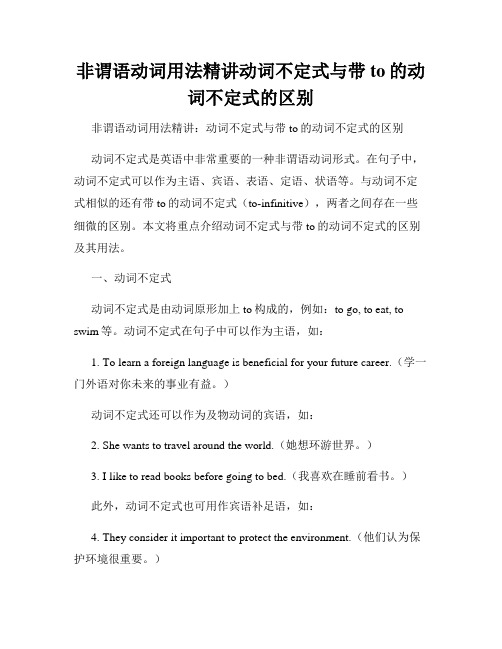
非谓语动词用法精讲动词不定式与带to的动词不定式的区别非谓语动词用法精讲:动词不定式与带to的动词不定式的区别动词不定式是英语中非常重要的一种非谓语动词形式。
在句子中,动词不定式可以作为主语、宾语、表语、定语、状语等。
与动词不定式相似的还有带to的动词不定式(to-infinitive),两者之间存在一些细微的区别。
本文将重点介绍动词不定式与带to的动词不定式的区别及其用法。
一、动词不定式动词不定式是由动词原形加上to构成的,例如:to go, to eat, to swim等。
动词不定式在句子中可以作为主语,如:1. To learn a foreign language is beneficial for your future career.(学一门外语对你未来的事业有益。
)动词不定式还可以作为及物动词的宾语,如:2. She wants to travel around the world.(她想环游世界。
)3. I like to read books before going to bed.(我喜欢在睡前看书。
)此外,动词不定式也可用作宾语补足语,如:4. They consider it important to protect the environment.(他们认为保护环境很重要。
)二、带to的动词不定式(to-infinitive)带to的动词不定式由to加上动词原形构成,例如:to learn, to eat,to swim等。
带to的动词不定式可以作为动词的宾语、表语、定语、状语等,例如:1. She decided to study abroad.(她决定出国学习。
)2. His dream is to become a doctor.(他的梦想是成为一名医生。
)需要注意的是,带to的动词不定式在使用时有以下几个特点:1. 带to的动词不定式通常作为及物动词的宾语,如:I want to go to the movies tonight.(我想今晚去看电影。
- 1、下载文档前请自行甄别文档内容的完整性,平台不提供额外的编辑、内容补充、找答案等附加服务。
- 2、"仅部分预览"的文档,不可在线预览部分如存在完整性等问题,可反馈申请退款(可完整预览的文档不适用该条件!)。
- 3、如文档侵犯您的权益,请联系客服反馈,我们会尽快为您处理(人工客服工作时间:9:00-18:30)。
不
定
式
用
法
4.动词不定式做状语 不定式做状语时,通常只表示目的,有时在to前面加 in order to用于强调。韩老来自师大课
堂
【知识精讲】
之 动词不定式组
主讲人 韩东升
动词不定式是由“to+动词原形”构成的 一种非谓语动词结构。
动词不定式的构成 动词不定式用法
动词不定式的特点 动词不定小口诀
动词不定式的构成
to+do (动词原形)是它的基本构成形式, 即不定式的标记。 如:I want to buy some ice cream.
小
口
诀
不定式有标记,to与动词连一起。
没有人称数变化,动词特点它具备。 主宾定状表补语,唯独作谓不可以。 not 加上不定式,否定结构要牢记。 疑问词与不定式,构成短语有意义。 仔细推敲多思考,准确判断有依据。
选出句中错误的选项,并在横线上改正。
( ) I want to am a football player in the future. ________ A B C
不
定
式
特
点
1.它没有人称和数的变化,不管主语是任何人称,单 数还是复数,动词不定式都没有变化。 2.但它仍保留动词的特点,可以有自己的宾语或状语 。
3.它具有名词、形容词和副词三大特点,所以,它在
句中可以作主语、宾语、定语、表语、状语和宾补。
不
定
式
用
法
1.动词不定式做主语: To study English is easy. It is easy to study English. 学习英语很容易。
如:I study English hard to find a good job. 我学英语是为了找一份好工作。
不
定
式
用
法
5.动词不定式的一些习惯用法:too……to、It is time to do sth.等。
如:He is too fat to walk.
他太胖了,都不能走路。
It is time to have lunch. (It is time for lunch.)
不
定
式
用
法
like, love, begin, start等动词后即可用不定式也可以用动名 词。它们之间的区别与做主语和表语时一样。有时界限并不十 分明显,可以换用。 如:I like to study English.
I like studying English.
我喜欢学习英语。
不
定
式
用
法
3.动词不定式做宾语补语:
不 2.动词不定式做宾语:
定
式
用
法
动词后接不定式做宾语完全是英语中的习惯用法,必须死记硬 背,并且养成习惯。是一些常跟不定式做宾语的动词 like
decide agree learn begin love want hope 等。
如:I want to study English. 我想学习英语。
答案:A; be
单项选择。 ( ) Can you teach me ________ ping-pong. A. play B. to play
C. plays
D. played
答案:B
韩
老
师
大
课
堂
End
韩东升 作品
更多精彩敬请期待下一期的韩老师大课堂
学生群:209637858 老师QQ:572803606
